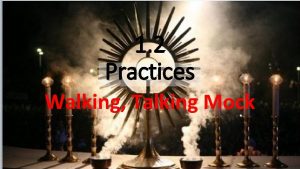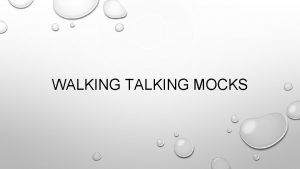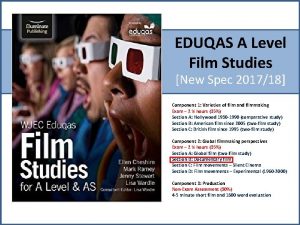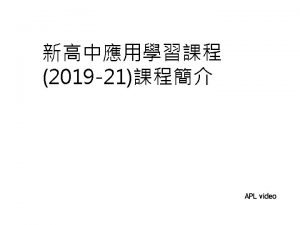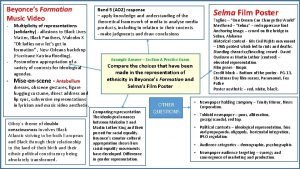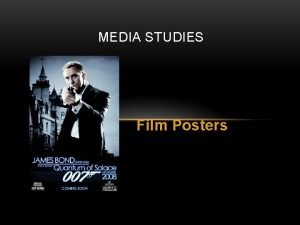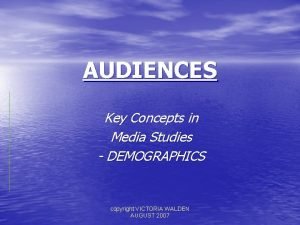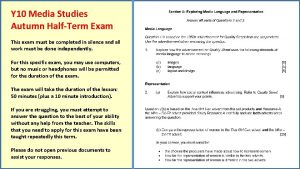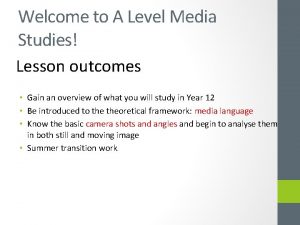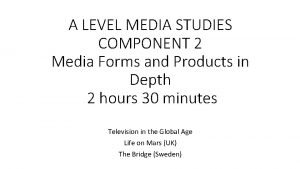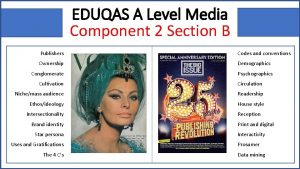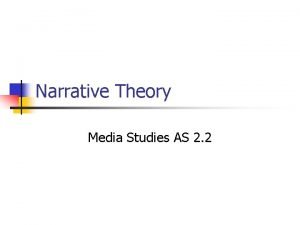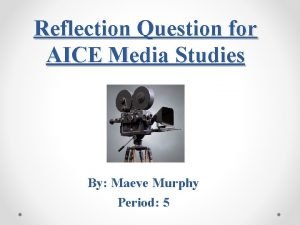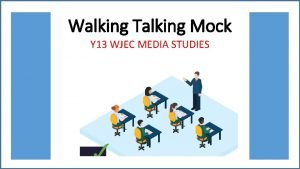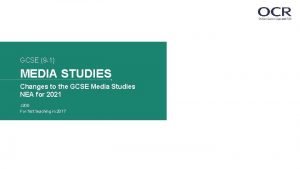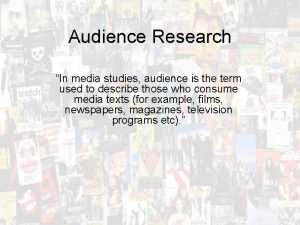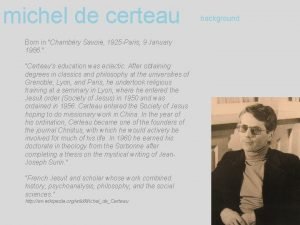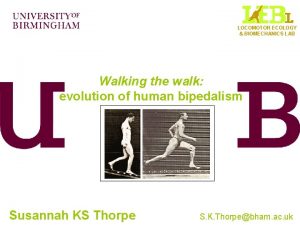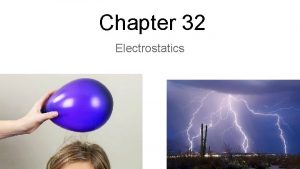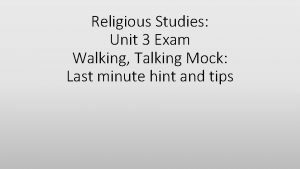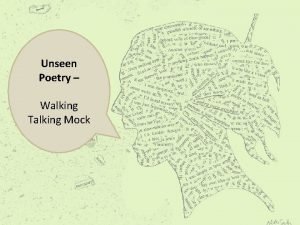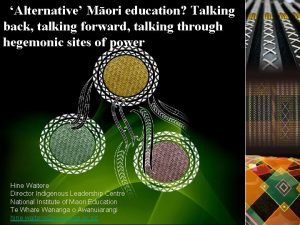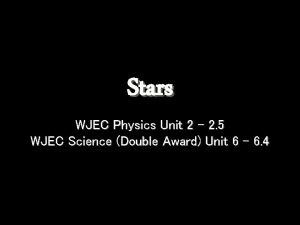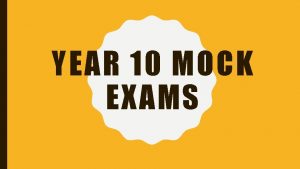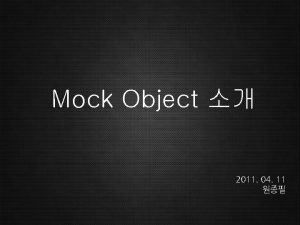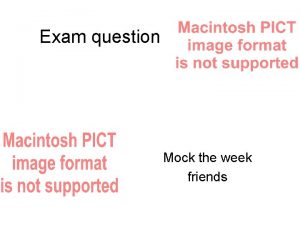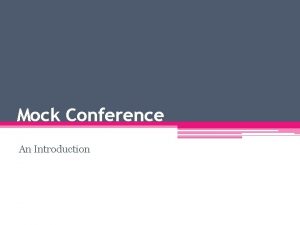Walking Talking Mock Y 13 WJEC MEDIA STUDIES





























- Slides: 29

Walking Talking Mock Y 13 WJEC MEDIA STUDIES

The A 2 Media Studies exam will be: Date: Wednesday 7 th June Duration: 2 hours 30 minutes Section A = 45 minutes (answer A 1 or A 2) - FILMS Section B (Part 1) = 45 minutes (answer B 1 or B 2) - MAGAZINES Section B (Part 2) = 45 minutes Additional time to check work = 15 minutes 30 marks for each section. 90 marks in total. RESPONSE STRUCTURE (answer B 3 or B 4) – TV ADVERTS

Section A Example Questions • ‘Media representations of people are often simplistic. ’ How true is this of the representations of people in your three main texts? • ‘Narratives generally follow a linear structure. ’ Discuss with reference to your three main texts. • ‘All media representations are constructed. ’ Discuss with reference to your three main texts. • ‘Media texts contain complex narratives. ’ How true is this of your three main texts? • To what extent do your three main texts challenge genre conventions? • Explore the key gender representations in your three main texts. Films studied: à Fight Club (1999, dir: David Fincher) à Skyfall (2012, dir: Sam Mendes) à The Hunger Games (2012, dir: Gary Ross) This question requires comparative techniques similar to an English essay. You can write three separate paragraphs on each film followed by a comparative fourth or you can interweave perspectives that identify similarities and differences throughout.

SECTION A: FILM ANALYSIS à You are meant to answer one question for Section A but must refer to three main texts you have studied (Fight Club, Skyfall, The Hunger Games). à Spend 45 minutes on this question. à 5 -10 minutes max on planning your response (mindmap, flow chart, bullet points, buzz words terms list, key sequences identification). à Use comparative techniques (connectives, counterconnectives, identifying similarities and difference to each film with active reference to the title). à Apply relevant terminology where appropriate, use critical writing techniques (avoid ‘I think’ and ‘it grabs your attention). à Discuss the intentions of the director, the effect on the spectator, the representation of characters/narrative, the genre conventions (subvert/conform),

Example Answer: To what extent do your three main texts challenge genre conventions? WWW ‘Skyfall’ (2012, dir: Sam Mendes) is part of the hugely popular Bond Franchise. Bond films are iconic in the take on spy films and over the years have even developed their own sub genre, hence the term ‘a Bond film’. As an audience, we expect to see a particular repertoire of elements in Bond films such as exotic locations, gadgets, large explosions, beautiful women and a slick looking Bond with suave behaviour. We are not disappointed with ‘Skyfall’ as it delivers on all of those things – locations like Shanghai, Macau and Istanbul work as dramatic backdrops to elaborate fight scenes. Severine is the iconic Bond girl in the film; serving her typical purpose to satisfy the male gaze and be the damsel in distress that Bond tries to save. In Bond’s first proper encounter with her, we see her hands shaking in an extreme close up and her rouged lips tremble with fear suggesting she is in danger and Bond will come to her rescue. In the same scene, Bond is dressed in his smart suit looking confident and strong – a typical feature of a Bond film. However, Daniel Craig’s Bond is an updated, modern one. Very unlike previous Bond films, we see his flaws (his excessive drinking, failing his physical and mental examinations) and he has to work to fight his own personal demons as well as Silva, the ‘Bond Villain ’. ‘The Hunger Games’ (2012, dir: Gary Ross) is a dystopian parable with allusions to novels like Orwell’s ‘ 1984’ and Huxley’s ‘Brave New World’ as well as the Japanese horror film ‘Battle Royale’. Catniss Everdeen is the female protagonist from District 12 elected to take part in a death-sport pitting districts against each other for the amusement of the elites and a macabre reality TV show distraction for the masses. This adaptation of the Suzanne Collins literary franchise subverts the gender normative representations stereotypical of action genre films like ‘Skyfall’ and the Bond franchise. This film is likely to appeal to fourth-wave feminists keen to see a progressive portrayal of the identity and role of women in narratives beyond objectification for the pleasure of the male gaze (as identified by Laura Mulvey). The narrative is politically provocative, representing a neo-fascist dictatorship and a martyr encouraging a revolution against this regime. The film is an allegory that rebukes media propaganda and what it takes to challenge systems of oppression in a world fraught with corruption. EBI ‘Fight Club’ (1999, dir: David Fincher) remains the most subversive, unconventional and complex film from the three chosen. Its hybrid genre (thriller, sci-fi, fantasy, melodrama, action, psychological, crime, horror, comedy) is indicative of an edgy new wave of contemporary cinema. Fincher has become an auteur specialising in controversial representations (for example: The Social Network, Gone Girl and Seven). He keenly inspects the role of gender in post-modern contemporary society. ‘Fight Club’ revolves around an unnamed insomniac narrator who befriends an anarchist named Tyler Durden (who turns out to be a schizophrenic figment of his imagination) and they both form an underground, illegal fight club in order to forge an identity for themselves. The glorification of violence and criminal activity is problematic at first viewing, but a post-modern reading of the text would view this behaviour as an extended metaphor for the state of a gender identity in crisis. It is clear that Fincher wishes to explore non-conformist ideologies as a result of the alleged failure of The American Dream. In ‘Fight Club’, masculine dysfunction and the need to define oneself in a world where so-called modernist advancement has led many Monday-Friday ‘ 9 -to-5’ workers into a cynical state of ennui and disillusionment. According to Baudrillard’s simulacra and simulation theory, reality has become blurred by our obsession with technology, that the fantasy world has become more real. ‘Fight Club’ exercises paradoxical illusions, where linearity is compromised, and the rules of the film are regularly broken. It is as if the spectator is merely a subject to be toyed with. ‘Fight Club’ explores the post-modern paradigm where truth is merely a concept and that our perception of reality must be mediated in a world that continues to redefine itself. The film regularly subverts conventions of known genres and is keen to challenge the spectator into active critical participation rather than passive consumption. Whilst ‘The Hunger Games’ and ‘Skyfall’ have certain subversive representations that break stereotypes of gender, class, race and ideological representation in cinema, they are distinctively conventional within the action genre. It is ‘Fight Club’ that is the most unconventional and challenging, re-defining tropes of narrative cinema beyond expectations of linearity and causality.

A 1 or A 2 Film Analysis Terms To Apply à Narrative Theory – Todorov à Levi Strauss’ Binary Opposition à Baudrillard’s Simulacra and Simulation à Postmodernism (check mind-map) à Ideology (check spectrum) à Auteurism (director’s distinctive stylistic features)

Reference to post-modernism is crucial when analysing ‘Fight Club’ Baudrillard’s simulation theory is the key academic reference Modernism – philosophical movement – transformations of 20 th century Western society – rejected certainty of Enlightenment thinking and religious belief – “make it new” – stream-ofconsciousness novel, abstract art, self-conscious style, experimental form, rejection of realism – creative revolution (science, art, technology) – power of human beings to create, improve and reshape environment – progress and growth emphasised. Post-modernism – as cultural production peaked, post-modernism became a new movement that critiqued the modernist era with scepticism, deconstruction and a post-structuralist mode of analysis – it is marked by a cyclical return to previous styles but adding new contextual meaning through bricolage. Deconstructing – picking apart media to find out the motive and purpose of a product, to the point of abstraction Subversive – challenging the conventions of previous media – anticonformist in nature Hybridity – the blurred boundary between high culture and popular culture – genres blend, sources of influence vary – media forms are juxtaposed Hall-of-mirrors/ paradoxical – from Escher’s drawn architectural illusions, to story-in-a-story narratives – to oxymoronic notions such as ‘loving hate’ – ambiguity and illusion reigns in the post-modern world Hierarchies of taste - - Blurring of high and low culture to create new meaning Self-conscious – one could argue that post-modern thinking is very narcissistic – looking in on oneself, taking one out of an experience and into theoretical – conceptual art for conceptual art’s sake (the Emperor’s New Clothes effect) Simulacra and Simulation (Baudrillard) - Blurred boundary between the real and imagined - Distinction between media and reality has collapsed - Reality defined by images and representations - This meta-conceptual realm is a form of hyper-reality - Deals with the ambiguity of polar opposites – artifice and authenticity Music video and postmodernism - the ‘three minute culture’ – the MTV generation length of peoples’ attention spans – fast editing, intense imagery - Relevant theory: Lyotard/Baudrillard/Jameson – ‘structures of feeling’ and ‘cultural logic’ - Guy Debord - Society of the spectacle – overly visual culture that pursues high levels of stimulation What is post-modernism? In its simplest form, postmodernism challenges assumptions ‘Truth’ is merely a concept – there is no right or wrong, merely interpretations – propaganda or ‘taste’ are the deciding factors regarding which ‘truth’ prevails at any given time - Sense of reality dominated by media images - Cultural forms can no longer hold up a mirror to reality because reality itself is saturated by advertising, films, TV, video games and print media - Truth claims via images are more problematic thanks to Photoshop technology – reality is distorted to either beautify or implicate, sometimes unrealistically - Mediation – media reality is the new reality – society must mediate between cultural forms in order to decide on the prevailing ‘truth’ Causality – many stories no longer follow a structured cause-and-effect pattern but mess with linearity and consequence – some stories decide to subvert the notion of ‘meaning’ Meta-narratives – disjointed narrative structures that play with casuality and linearity – usually associated itself with avant-garde movements Bricolage - fusing two cultures can change its meaning – punk socialists (particularly bands like The Clash) would have a very different ethos to swastika sporting neo. Nazi punks - Iconography can be adapted when combined with icons from another cultural expression, and therefore create a very new meaning The zenith of cultural production – culture ‘eats itself’ – everything has been made – therefore, culture must remake itself in abstract and cyclical forms of self-reference - Many artistic products are influenced by its predecessors to the point of parody, homage and intertextuality - anything can be art - Reflection of an ‘alienated’ society – personas and characters are reinvented (ie. Madonna, Michael Jackson, David Bowie) as the pursuit for identity subverts conventions

CONTROL NATIONALISM FASCISM TOTALITARIANISM NATIONALISTIC SOCIALISM TRADITIONALISM AUTHORITARIANISM STATISM anti-freedom FUNDAMENTALISM Ideology NATIONAL COMMUNISM REPRESENTATION AUTHORITARIAN dictate state focused CONSERVATISM SOCIALISM NEOLIBERALISM Right LEFt SOCIAL DEMOCRACY COMMUNITARIAN LIBERALISM ECONOMY TARIAN PROGRESSIVISM welfare of the people welfare of the economy DEMOCRATIC SOCIALISM LIBERTARIAN CAPITALISM LIBERTARIAN freedom of the individual ANARCHOSOCIALISM ACTIVISM LIBERTARIANISM INDIVIDUALISM SYNDICALISM MUTUALISM ANARCHOCOLLECTIVISM ANARCHOCAPITALISM ANARCHOCOMMUNISM LIBERTARIAN SOCIALISM ANARCHISM CONNECT relate CHAOISM anti state

Todorov’s Narrative Theory Restored Order Tension Realisation Disruption 3 2 5 1 Equilibrium 4 New Equilibrium Time

NARRATIVE Todorov’s Narrative Theory 1 – EQUILIBRIUM – introduction of characters, setting and context. Some narratives will have a sense of harmony, mundanity and the feeling of the every day at the beginning. 2 – DISRUPTION – a problem is introduced to the narrative that propels the rest of the story. 3 – REALISATION – chaos and tension grow as the disruption causes a series of problems. Characters aim to achieve a goal but are in conflict with obstacles to it. 4 – RESTORED ORDER – when the characters may amend their problems and all conflict comes to a head. 5 – NEW EQUILIBRIUM - when the problem is resolved and all normality can resume again.

Claude Levi-Strauss’ Propp’s Stock Characters 7 Types Examples of Binary Oppositions • good / evil • original / copy • primary / secondary • inside / outside • soul / body • pure / corrupted • father / son • male / female • speech / writing • • • center / margins normal / deviant straight / gay white / black self / other truth / fiction master / slave teacher / student high culture / pop culture network TV / cable TV base / superstructure Hybrid Genre A cross-genre (or hybrid genre) is a genre in fiction that blends themes and elements from two or more different genres. A subgenre is a subordinate within a genre. [15][16] Two stories being the same genre can still sometimes differ in subgenre. For example, if a fantasy story has darker and more frightening elements of fantasy, it would belong in the subgenre of dark fantasy; whereas another fantasy story that features magic swords and wizards would belong to the subgenre of sword and sorcery. 1. The villain: Locked in a constant struggle with the hero, often trying to harm princess. 2. The donor: Gives the hero an object or a piece of information that helps them prepare for what is to come. 3. The helper: Assists the hero with their quest, often referred to as their 'sidekick'. 4. The princess: Needs assistance from the hero, usually because they are in some form of danger, typically the princess is the victim within the narrative. 5. The dispatcher: Is the character who sends that hero on their mission or quest. 6. Hero: Reacts to the donor and saves the princess, often resulting in them falling in love with the princess. 7. False hero: May appear good but has an ulterior motive, or attempts to take credit for the hero's actions. Breaking the fourth wall The fourth wall is a performance convention in which an invisible, imagined wall separates actors from the audience. "Breaking the fourth wall" is any instance in which this performance convention, having been adopted more generally in the drama, is violated. This can be done through either directly referencing the audience or the work they are in, or referencing their fictionality. The temporary suspension of the convention in this way draws attention to its use in the rest of the performance. This act of drawing attention to a play's performance conventions is metatheatrical. A similar effect of metareference is achieved when the performance convention of avoiding direct contact with the camera, generally used by actors in a television drama or film, is temporarily suspended. The phrase "breaking the fourth wall" is used to describe such effects in those media. Breaking the fourth wall is also possible in other media, such as video games and books. Action comedy (action and comedy) Comedy-drama or dramedy (comedy and drama) Comedy-horror (comedy and horror) Comic fantasy (comedy and fantasy) Comic science fiction (comedy and science fiction) Crime fantasy (crime and fantasy) Dark fantasy (horror and fantasy) Romantic comedy (romance and comedy) Romantic fantasy (romance and fantasy) Science fantasy (science fiction and fantasy) Science fiction Western (science fiction and Western) Supernatural drama (supernatural and drama) Tragicomedy (tragedy and comedy) Weird West (Western and horror, science fiction and/or speculative elements ) Spectacle - a visually striking performance or display. Spectacle can also refer to a society that critics describe as dominated by electronic media, consumption, and surveillance, reducing citizens to spectators by political neutralization. Recently the word has been associated with the many ways in which a capitalist structure is purported to create play-like celebrations of its products and leisure time consumption. Trope - A trope is a storytelling device or convention, a shortcut for describing situations the storyteller can reasonably assume the audience will recognize. Tropes are the means by which a story is told by anyone who has a story to tell. We collect them, for the fun involved. Tropes may be brand new but seem trite and hackneyed; they may be thousands of years old but seem fresh and new. They are not bad, they are not good; tropes are tools that the creator of a work of art uses to express their ideas to the audience. In fiction, it can even be impossible to create a tropeless tale

Propp’s Narrative Functions • The typical sequence of functions is: • 0: The Initial Situation - The setup. • 1: The Absentations - Someone leaves or dies. Usually a parent. • 2: The Interdiction - A big rule is set up. Don't touch the spinning wheel. You can't go to the ball. You know the drill. • 3: Violation - Someone breaks the big rule. This could be good or bad as seen by the examples above. • 4: Reconnaissance - The villain spies on the hero or the hero learns about the villain. • 5: Delivery - The searching party discovers information. • 6: Trickery - Villain tricks hero. • 7: Complicity - The hero is forced, tricked or influenced by magic to do something bad. There are bad consequences. • 8: Villainy - Baddy Mc. Badson does something really evil, normally stealing the Macguffin or kidnapping the princess. • 9: Meditation - The goodies figure out a plan and get ready to set out on their quest. • 10: Beginning counteraction - The heroes choose to fight back. • 11: Departure - They. . . depart. Voluntarily or not. • 12: First function of donor - The hero run into a donor or a magic dude. This character can be The Obi-Wan, a mysterious beggar or a "None Shall Pass" kind of character. They may have to pass a test. The hero may have to fight the donor. But on the bright side, the donor may have a magical object to help them on their quest. • 13: Protagonist reaction - The hero outsmarts, outfights or finds a way around the donor's demands. He gets the Macguffin. 14: Acquisition of Magical Agent - The obi-wan type character. Can be the donor. This character helps the hero on his quest, sometimes willingly, sometimes not. 15: Transference - The hero is taken to a new place. Physically. Emotionally. Spiritually. Grammatically. 16: Struggle - Our hero (surprisingly) struggles. 17: Branding - Our hero for his efforts is marked out as a hero either with a token or with a mark on his body. 18: Victory - The hero beats the villain with his wits, his special abilities or his brawn. 19: Liquidation - The goodies all help the hero, and get what they were after. 20: The Return - Guess. 21: Pursuit - The heroes are chased by the villain, who is going all One-Winged Angel on them. 22: Rescue - The goodies run for it and escape by placing obstacles in the villain's path. 23: Unrecognised - The hero comes home and no one knows who he is because. . . 24: Unfounded Claims - Some Il Capitano-Zapp Brannigan-Gilderoy Lockhart character claims he saved the day. 25: Difficult Task - To prove he's the Hero must, well prove himself. It can be an ordeal of choice, a riddle or a test of strength. 26: Solution - The Hero chooses right/guesses right/wins the fight. 27: Recognition - Everyone realises that the hero is the hero through his special mark, the fact they got the right solution or through simple recognition. 28: Exposure - The false hero is shown up. 29: Transfiguration - The hero gets a makeover. Or at least new clothes or a palace. 30: Punishment - False Hero and Villain (and yes, they can be the same guy) get what's coming to them. 31: The Wedding - Usually the hero marries the princess or something like that, but the wedding can just be a general celebration from getting crowned to a party.

SECTION B (PART ONE) - MAGAZINES GQ or Men’s Health Glamour Pride àFrom micro analysis to macro analysis. - textual analysis of aesthetic (front cover to articles). - ideology, identity, context, purpose and overall ethos.

Section B Example Answer (Magazines – Men’s Health, Glamour, Pride) Explore how the three texts appeal to different audiences. WWW Media texts will construct certain features to appeal to audiences. Some media texts will try to appeal to a niche audience in which they will only include content specific to that audience. However, some media texts will try to appeal to a mass audience to attract as many audiences as they can possibly get. The techniques used to construct media texts will aid in the appeal of the media text. In this essay, I will discuss the audience appeal of the magazines ‘Glamour’, ‘Pride’ and ‘Men’s Health’. ‘Pride’ magazine is a fashion and beauty magazine constructed to appeal to African-Caribbean women. It can be argued that this magazine appeals to a niche audience as most of the content is specific to demographic. For example, the front page of the April 2017 issue directly appeals to the audience with cover lines such as ‘The Black Rich List 2017’. This cover line directly addresses the readers of this magazine who are aspiring young black women because it encourages ambition beyond average goals. In addition, the mode of address of the anchoring image is also an appealing factor of the magazine. The model is directly looking into the camera lens which connects her with the audience and establishes a confident tone to the magazine’s discourse. The mode of address of the magazine is also formal which is another appealing feature of the magazine for aspiring black women. The content of the magazine is also appealing to the target audience, for instance, it contains information on beauty products specific to African-Caribbean women. It also contains images and articles on successful and influential black women such as Oprah Winfrey. This is another appealing feature of the magazine that will appeal to young black women that look up to individuals like Oprah. As a result, this magazine appeals successfully to its target audience as the main audience are university graduates of the African-Caribbean ethnicity. The magazine aims to inform as well as entertain. The cover line ‘Jane takes Hollywood’ emphasises the audience’s familiarity with the star. So much so, that her surname does not feature. Janelle Monae is a famous actress (Hidden Figures) and singer-songwriter. The cover line suggests that she has conquered the industry – another example of a successful black woman in showbiz. The red aesthetic is a bold stylistic choice demonstrating the confident discourse of the magazine. EBI Moreover, ‘Glamour’ magazine is a fashion and beauty magazine that appeals to a mass audience compared to ‘Pride’ magazine’s niche audience. As the audience demographic for this magazine, ‘Glamour’ readers are 97% owners of premium beauty products and 87% designer fashion owners. This means that ‘Glamour’ magazine will include prioritise style as part of their discourse. For example, the front cover of the ‘May 2017’ issue promises “Gorgeous ruffles and the Yellow dress that suits everyone. ” This cover line is appealing to the audience and gratifies their needs with inclusive emotive description and fashion terminology. Also, cover lines such as “Amy Schumer on fire, in love, always unfiltered” is appealing to fans of Amy Schumer who may purchase this issue to find out more about her love life. By reinforcing that the image is ‘unfiltered’, it emphasises the authenticity of it. This subverts the photoshop phenomenon (where images are manipulated often to conform to ‘size zero’ expectations of ‘beauty’) which has been criticised in this type of magazine because it sets unfair expectations about body image. The mode of address of this magazine is informal and direct. They ask the audience rhetorical questions such as “Is your address killing your career? ” which suggests the importance of status to the reader. The main cover line of this issue (‘ 406 Hot Buys’) is appealing to the consumerist readers of the magazine. This will attract audiences that want to be educated on the trendiest new beauty and fashion related products on the market. Furthermore, ‘Men’s Health’ magazine is a fitness magazine constructed to appeal to aspirational men. As a result, many of the features of the magazine will be constructed in a way to appeal to their audience. For example, the ‘May 2017’ issue front page issue displays many features that appeal to their target audiences. It incorporates cover lines that demand the audience to “Feel Young Again” and some that tell them to “Pump Up Your Salary”. These imperatives add a commanding tone underlined by the emphasis on masculinity. These cover lines are appealing to young men that want to improve their fitness, careers and other aspects. Consequently, the magazine meets the needs of the audience. The mode of address of this issue is direct with the cover lines demanding the audience’s attention. The anchoring image is also adhering to the main discourse of this magazine as the model is fit and successful. ‘Men’s Health’ focuses frequently on the importance of the six-pack abs. Body image is reinforced as an example of ideal masculinity. The core demographic of ‘Men’s Health’ would be aspirational alpha male metrosexuals. The inference is by achieving a strong and healthy body, your status as a man will improve. They implicitly encourage hegemonic masculinity through depictions of the fit man. In conclusion, the magazine industry will, in general, construct their media texts to appeal to audiences. These magazines will incorporate their ideologies and messages into their media text. If the text appeals to the audience, then they are more likely to accept the preferred reading of the text. Each magazine also uses a superimposed anchoring image over the masthead which illustrates their confidence regarding brand recognition.

B 1 or B 2 Magazine Analysis à The magazine discourse - how is the magazine aesthetic and semantics mediated? - what identity has the magazine developed over time? à Audience positioning and representation – Hall (preferred, negotiated, oppositional reading) - demographic/readership – gender, culture, nationality, age. - collective representation and ideological agenda. – politics, belief, agenda, message of magazine. - mass or niche audience? - global context: house style and unique selling points (USP). à Media Regulation in Magazine Publishing - Libel laws, defamation, slander, gatekeeping, super-injunctions. - The standards upheld alongside ‘freedom of the press’ laws.

Media Regulation The Byron Review (2008) – Media may have some influence on negative behaviour in children but should not be singled out as a cause. – Sociocultural and psychological contexts are also crucial. - There is no evidence of ‘desensitisation’ from playing video games – The idea that games are addictive is based on prejudice. - However, the BBFC’s steady liberalisation since late 1990 s and creation of Ofcom has led to more emphasis on ‘self-regulation’ (parents not institutions). - The relatively unregulated internet is contentious. Media regulation key words Media regulation = the control or guidance of mass media by governments and other bodies. Gatekeeping = the process through which information is filtered for dissemination, whether for publication, broadcasting, the Internet, or some other mode of communication. Classification = preventing people from accessing material that is deemed unsuitable for their age. Censorship = removing material from public material altogether. Moralists = believe that people need to be protected from the harmful effects of the media. e. g. parents believe children need to be controlled in using video games. Pluralists = believe that people should choose what they watch. Press regulation Normative Theory - Press should be mirroring public opinion and interest whilst be fully inclusive of any apparent, important or impending affairs. - It is argued that, this along with a free press, is the ideal situation. - However, a free press often leads to press abuse, ideological radicalisation and an infringement on the human rights of the subject of journalistic investigation. Super Injunctions - A super injunction is a means in which a body can submit a block of all media coverage regarding an event. - This prevents UK papers and news sources from reporting any information on the event, even if in ‘the public interest’. - Super injunctions are often used to hide embarrassing personal stories, for instance, celebrities who have had affairs or have solicited prostitutes. - The problem with a super injunction is the ability to fully hide a story in this social media era is impossible. - The Leveson Report – a government initiated inquiry into press abuses that included hacking scandals and examples of defamation, slander and libel by newspapers such as the News Corporation (Rupert Murdoch) owned ‘News of the World’, as well as ‘The Mirror’ and ‘Daily Mail’. - Press Complaints Commission (PCC) – non-government voluntary organisation and has no statutory or legal powers. Newspapers would use a ‘publish and be damned’ ethos because damages if sued would be worth the hassle. - Big, rich newspaper organisations that can afford the occasional defamation/libel/slander case. The PCC was a form of self-regulation as many on the board were ex-news editors. After The Leveson Inquiry revealed the PCC’s incompetence, it disbanded in 2012. - Independent Press Standards Organisation (IPSO) is a new press regulator set up after the Leveson Inquiry.

Introduction - majority of magazines have a global presence - reach out to a wider audience (increasing profits). - global demographic for GQ, MH and Glamour – consider house style across nations. - Pride is UK National. Conclusion - All 3 use globally recognised C+Cs of a magazine to reach out to a wide audience. - GQ and MH most global. Men’s Health GQ Glamour Pride Published in 48 countries Metrosexual men is more Glamour’s representation Black women – – discourse is universal common is Westernised of women is globally celebration of Afro(e. g. body image – “shred society (US and UK). accepted. Caribbean culture your gut”) Representation of men globally accepted (Scott Eastwood as macho man) Yuppie ‘new man’ culture Celebration of liberal – the young, upwardly femininity – open-minded mobile professional. sexuality, aspirational career focus, appreciation of fashion, nuanced reflection on identity. Aspirational audience hoping to gain the ideal physique – money, sex, sporting prowess. Arguably chauvinistic values encouraging male gaze objectification of women. British - and progressive multicultural racial identity in contemporary Western society Focus on relationships, Smallest magazine role model celebrities, company zeitgeist style and lifestyle advice. Discourse - emphasis on Discourse Conforming to healthy lifestyle including upper-middle class diet as well as exercise. ‘gentleman’ lifestyle ethos (designer label fashi on, cocktail parties, smart attire, emphasis on masculine maturity. Amy Schumer – body image subversion of ‘Vogue’ size zero template – encouraging feminine representation beyond Barbie stereotypes of beauty. Different discourse – celebrating the success of African culture Mass audience. Niche Mass audience

Social Class Demographics (Savage) The millennial ‘seven-class’ system Elite Established Middle Class New Affluent Workers Technical Middle Class Emergent Service Workers Traditional Working Class Precariat

Superimposing anchoring image over masthead Buzz word Secondary Leads/Strip Masthead Anchoring Image Font features – uppercase, bold font, some italics, colours: black/ yellow/ white Cover story/headline Colour scheme - black, yellow, white Coverline /kicker Promotion/ sponsorship Hyperlink Lure Bar Code Overall aesthetic – C Cover Design Main coverline

Denotations of a magazine cover • Masthead – magazine title and logo, usually featuring a slogan underneath. • Masthead acronym – for example: NME = New Musical Express. • Secondary leads/strip – a line of extra features in the magazine usually at the top and bottom of the cover. • Colour scheme – specific, dominant colour patterns on a magazine page. • Font – uppercase/lowercase, colour, size, style, bold, italic, underline, alignment of text. • Anchoring images – the biggest image on the front cover which usually fills the page. • Superimpositions – images can be superimposed (put over the top of) text or vice versa for certain effects. • Buzz words – usually with the main feature of the article. Used to attract attention (for example: “EXCLUSIVE, FREE, NEW, PLUS”. • Plug – by the logo or barcode advertising the magazine with buzzwords or taglines. • Lure – marketing device – usually a word or phrase to make the reader look inside the magazine. • Coverline (kicker) – additional stories and features as headings and sub-headings that are included in the magazine and are advertised on the front page. • Puff – offers something else to the magazine such as free giveaways. • Hyperlink – website address to the magazine online. • Bar code – the pricing key usually aligned in corners of the front cover or by the logo/masthead. Denotation – what you see in a media text – describe literally. Connotation – what it means – symbolism, significance, purpose, deeper message.

Additional terminology to consider: • Mode of address - how the text speaks to the audience, and involves them. It also refers to how a text influences the audience. • C Cover Theory – C-shaped design of the text around the anchoring page on the front page. • T Motion – T-shaped design of text on front page – centring device. • Narrow casting – target/niche audience. • Circulation figures – quantity of magazines sold per cycle of distribution. • Multi-platform – apps, e. Books, interactivity, digital download. • Digital vs. Print – which medium is in trend? • Aesthetic – the look or visual style of the magazine. • Layout – the formatting of sub-headings and coverlines throughout the magazine. • Discourse – the wider context and discussion surrounding the magazine. • House style/brand – the recurring motifs of the international magazine (logo, aesthetic, design, layout) • Publishers – Conde Nast, Bauer Media, IPC Media, Rodale

The Alpha Male The Beta Male Representations of masculinity: Alpha – Beta – Omega Male - Stereotypes and Archetypes – which type of man is dominant in contemporary society? - Gender hegemony – the historical context of dominant masculinity, patriarchy and the alpha male. - Identity - Metrosexual / heterosexual / homosexual / bisexual. - Generations - The differences between traditional, modern and post-modern representations of masculinity. - The difference between being a boy and being a man – explored in films like ‘Kidulthood’. - Post-modern reactions to gender studies – from alt-right anti-feminist movement, male feminists, to evaluations of masculine dysfunction and masculinity in crisis – attitudes to gender have become increasingly complex and fraught. - Men’s Rights Movement (MRM) – backlash against feminism who consider misandry a bigger issue than misogyny. - The Feminist Man – Justin Trudeau (Canadian PM) is an example of a trend of men supporting feminism. Basic categorizing of types of men: The Omega Male The Alpha Male (James Bond, Rocky, Clint Eastwood, Bruce Willis, Arnold Schwarzeneggar, Captain America, Don Draper in ‘Mad Men). - Machismo, rugged, denim, facial hair, violent, aggressive, tough, protector, breadwinner, patriarch, open shirt/medallions, control, heroism, the leader, part of the boys club, ‘man up’, the big shot professional, the strong silent type, the jock, dominant. The Beta Male (Joseph Gordon Levitt, Aziz Ansari, Jesse Eisenberg, Michael Cera, Zach Braff). - the post-feminist man, sensitive and emotional, at times effeminate, introverted, the nice guy, avoids confrontation, more comfortable around women, submissive, can be metrosexual. The Omega Male (Zach Galifianakis, Seth Rogen, Breaking Bad, The Big Bang Theory guys). - the loser stereotype, the lazy and feckless, isolated, outsider, the creepy weirdo stereotype, the stoner druggie, freaks and geeks, the joker, the fool. https: //en. wikipedia. org/wiki/Hegemonic_masculinity

IDEOLOGY Feminism – Mulvey’s ‘Object of the Male Gaze’ Theory The Bechdel Test https: //en. wikipedia. org/wiki/Bechdel_test The Bechdel Test is a very simple concept that underlines the sheer totality of misogyny and patriarchal dominance within contemporary media. The majority of films fail to pass this simple test: “are there two named female characters who talk to each other about something other than a man? ” As a critique of trends of modernism, this test is a highly effective starting point. Other notable Feminist theorists: Judith Butler – Gender Trouble Simone de Beauvoir – The Second Sex Mary Wollstonecraft – A Vindication of the Rights of Woman Germaine Greer – The Female Eunuch Naomi Wolf – The Beauty Myth Andrea Levy – Raunch Culture Miss Representation http: //www. veoh. com/watch/v 39771873 Amj 6 RRWb ‘Miss Representation’ is a compelling documentary that analyses media representation and pervasive gender discrimination against women. Whether in magazines, films, adverts, TV programmes, newspapers, theatre, and a variety of industries, gender equality is still lacking in these fields. The documentary deals with pay inequality across all industries, disproportionate gender representation in executive positions, the non-consensual sexualisation of women in media, gender stereotyping, exploitative objectification. The semiotics of media representation is aptly deconstructed with a feminist lens. à The ‘male gaze’ theory can be traced back to Laura Mulvey’s essay ‘Visual Pleasure and Narrative Cinema’ published in 1975. à In this essay, Mulvey states that women in film are typically objects of the gaze – meaning women on screen are seen as the objects of desire. à Mulvey believes that film audiences have to view characters from the perspective of a heterosexual male and this is the reason women are seen more as objects. à In the era of classical Hollywood cinema, audiences were encouraged to identify with the protagonist of the film – who was usually male. à Whereas, Hollywood female characters of the 1950 s and 60 s were, according to Mulvey, coded with ‘to-be-looked-at-ness’. à Laura Mulvey’s thesis on the ‘object of the male gaze’ has become synonymous with feminist critique. à She is the quintessential 1970 s scholar who challenged paradigms of media with regards to the representation of women. à While Emmeline Pankhurst represented the Feminist Movement of the early 20 th century with the Suffragette Movement, Mulvey remains a figure of applying post-modernist deconstruction methods to the study of gender. à Her identification of the voyeuristic nature of male objectification on women and its socio-cultural effects is aptly described in ‘Visual Pleasures and Narrative Cinema’. See also: Julia Kristeva and Jean Kilbourne.

INDUSTRY AND AUDIENCE – B 1 or B 2 Section B (Part 1) Example Questions • Discuss the different ways audiences are positioned by your three main texts. • All media texts are subject to regulation. How has regulation affected your three main texts? • Explore the different audience appeals of your three main texts. • Discuss the importance of social media in the marketing and promotion of your three main texts. • Discuss the marketing strategies used by your selected industry. Refer to your three main texts. • How important are high production values to your three main texts?


INDUSTRY AND AUDIENCE – B 3 or B 4 Section B (Part 2) Example Questions • Explore the key factors which influence the production of your three main texts. • Discuss actual audience responses to your three main texts. • To what extent do your three main texts target a global audience? • How important are digital technologies to the success of your three main texts? • Explore the different ways audiences respond to your three main texts. • To what extent do your three main texts target a mainstream audience? Adverts Studied: à Coco Chanel Mademoiselle (https: //www. youtube. com/watch? v=a. RV-2_Un-kk) à M&S Christmas Advert (https: //www. youtube. com/watch? v=V 5 QPXh. Stb 5 I) à Women’s Aid (https: //www. youtube. com/watch? v=w. Eyb. VOerb 9 Q)


Adverts: To what extent do your three main texts target a mainstream audience? Coco Chanel Mademoiselle M&S Christmas Advert 2016 Women’s Aid Billboard and Poster Star power (Keira Knightley) is one of the Unique Selling Points (USP) for this advert – Coco Chanel targets a mass audience (primetime terrestrial television and mainstream magazines) – designer label brand – fragrance. Brand recognition - UK high street fashion label and uptown Interactive Intertitles on an electronic billboard - ‘Look At supermarket brand – upper middle class high street brand – Me’ – ‘ You Can Stop It’ – If You Can See Domestic Violence’ classical instrumental background theme (piano, strings). Moving image – bruised womens’ faces – direct address eye contact of blinking woman. Aspirational audience – Knightley is a Hollywood elite actress with the chic style of Audrey Hepburn – her endorsement of this perfume encourages an audience to purchase the product who wish to aspire to her level of beauty, glamour and acclaim. Context - Advertising Christmas – widely celebrated festival – beyond the Christian conception – family demographic (kids, Mrs Claus, Santa Claus, Dad, Mum). Agenda – to shock the audience into facing the taboo of domestic violence head on – challenges the notion of ‘behind closed doors’ when aggressive tendencies lead to abuse in the home. Purpose of the advert – to glamorise the brand to present female identity in an empowered and liberal fashion. Knightley is in control of her sexuality, flirting with the photographer without ever fully yielding to his desire for her. Science-fiction/fantasy elements – doors flying open by magic, presents moving by telekinesis. Ideology – profound feminist message raising awareness for the marginalisation of those in toxic relationships. Established brand – high fashion house specialising in haute couture, luxury goods, apparel and accessories. They have built a reputation alongside designer labels that appeal to yuppies, fashionistas and middle/upper class audiences. Synopsis - Unique Selling Point - Epic scope of narrative – Mrs. Claus gives a present on behalf of a boy who requests new shoes for his sister – family scene - Mrs. Claus sneaks off to give a present whilst Santa is out giving the presents – dramatic irony – Santa doesn’t find out about her secret present giving. The slight movements on the billboard emphasise the haunting quality of violence. The direct address eye contact of the victim of domestic violence makes the viewer feel involved in the situation. Regulation – implied sexual content - objectified by the male gaze (Mulvey theory) – Keira Knightley is so empowered that she transcends objectification – the photographer captures flirtatious images of Knightley posing in bed, but she leaves him by climbing on drapes out of the room onto her motorbike – she is very assured and in control of her sexuality. Aesthetic – two locations: (red Santa and Mrs Claus) 1 - Lapland – fireplace inside, snow outside, and a house full of letters) and homely bric-a-brac. 2 – The boys’ UK home – upper middle class house. The target audience for this advert would be the majority of society – from the victims and witnesses of abusive acts to the perpetrators themselves. Voiceover of the boy’s letter to Mrs Claus – flashback to scenario featuring the boy’s sister who gets her shoes ruined by the dog The capital letters and imperative language ‘LOOK AT ME’ emphasises its confrontational tone – its message is not to avoid the conversation. Professional, glossy, stylised cinematography & mise-en-scene. Subversion of myth – Mrs Clause rides a helicopter rather than sleigh, she walks through front door rather than down At the bottom of the advert, there are pedestrians walking on the street filmed live – this is to emphasise that everyone

Example answer (Section B, Part 2): To what extent do your three main texts (Coco Chanel Mademoiselle, Marks & Spencer’s Christmas Advert 2016 and Women’s Aid interactive billboard) target a mainstream audience? WWW Media texts will target audiences to ensure that their products sell. When the media text is constructed, the audience are considered and the producers will include particular features that will encourage them to consume the product. Some texts will target niche audiences in which the content of the text will be very specific. However, some media texts will target a mass audience to maximise the number of people they reach. The way in which the media text is constructed will help target the audience. I will discuss in this essay to what extent the campaigns ‘Coco Chanel Mademoiselle’, ‘Marks and Spencer 2016 Christmas Advert’ and ‘Women’s Aid interactive billboard’ target a mainstream audience. The 2011 ‘Coco Chanel Mademoiselle’ advert targets a mainstream audience. This can be identified through the distribution of the campaign. The star power of Keira Knightley is one of the Unique Selling Points (USP) for this advert – ‘Coco Chanel’ targets a mass audience (with primetime terrestrial television (such as ITV, Channel 4 and Sky channels) and mainstream magazines advertisting slots (such as ‘Glamour’ magazine) as a designer label brand popular ‘Mademoiselle’ fragrance. The advert appeals to an aspirational audience because Knightley is a Hollywood elite actress with the chic style akin to Audrey Hepburn. Her endorsement of this perfume encourages an audience to purchase the product who wish to aspire to her level of beauty, glamour and acclaim. The purpose of the advert is to glamorise the brand to present female identity in an empowered and liberal fashion. Knightley is in control of her sexuality, flirting with the photographer in the bedroom scene sequence without ever fully yielding to his desire for her. Third-wave feminism has seen a rise in sexually expressive and empowered women in control of their identity. This representation is very popular in mainstream advertising. ‘Coco Chanel’ is an established brand; a high fashion house specialising in haute couture, luxury goods, apparel and accessories. They have built a reputation and legacy alongside designer labels that appeal to yuppies, fashionistas and middle/upper class audiences. Coco Chanel was a famous French designer who has become a distinct icon in the history of fashion. The advert contains professional, glossy, stylised cinematography with elaborate settings and costumes. . Laura Mulvey’s ‘male gaze’ theory can be applied to this presentation of her character. This is because her character is objectified and sexualised for the male gaze. However, at the end of the advert, her character is empowered as she rejects the man and transcends objectification. Although this advert is targeted at a mainstream audience, the advert would only appeal to audiences that can relate and connect with the campaign. This means that mainly people that are brand owners are more likely to be attracted to the advert and are more likely to buy the perfume. EBI The ‘Marks and Spencer’s Christmas Advert 2016’ also targets a mass mainstream audience. It is essential for this advert to target a broad demographic in order to reach as many people as they can which will maximise their sales. One way M&S target a mainstream audience is their brand recognition. UK high street fashion label and uptown supermarket brand upper middle class high street brand. They capitalise on the seasonal increase in consumption. Christmas is renowned for a surge in sales. The classical instrumental background theme (piano, strings) sets an appropriate seasonal tone. As a widely celebrated festival beyond the Christian conception, the advert focuses on a fictional family demographic (kids, Mrs Claus, Santa Claus, Dad, Mum) based on festive folklore. The unique selling point is the epic scope of narrative – a feature advert. Mrs. Claus gives a present on behalf of a boy who requests new shoes for his sister. It is a family scene - Mrs. Claus sneaks off to give a present whilst Santa is out giving the presents. There is dramatic irony in these representations because Santa doesn’t find out about her secret present giving. There are Science-fiction/fantasy elements such as doors flying open by magic, presents moving by telekinesis. Festive consumption thrives on fantastical representation. The aesthetic of two locations (where red Santa and Mrs Claus reside) are Lapland the boys’ English home. The contrast between the real and the magical is emphasised. The voiceover of the boy’s letter to Mrs Claus leads to a flashback to scenario featuring the boy’s sister who gets her shoes ruined by the dog. Despite appealing to a mass audience, there is an attempt to subvert or progress the festive myth – Mrs Clause rides a helicopter rather than sleigh, she walks through front door rather than down chimney. For the ‘Women’s Aid’ advert, interactive intertitles on an electronic billboard saying ‘Look At Me’ and ‘ You Can Stop It’ – If You Can See Domestic Violence’ are projected. There is a moving image of bruised womens’ faces. Each person gives direct address eye contact to the viewer, slowly blinking. The agenda of the billboard to shock the audience into facing the taboo of domestic violence head on. It challenges the notion of ‘behind closed doors’ when aggressive tendencies lead to abuse in the home. The ideology of the advert is to promote a profound feminist message and raise awareness for the marginalisation of those in toxic relationships. The slight movements on the billboard emphasise the haunting quality of violence, almost slightly unreal with an uncanny resemblance to reality. The direct address eye contact of the victim of domestic violence makes the viewer feel involved in the situation. These stylistic techniques emphasise the surreal nature of trauma. The target audience for this advert would be the majority of society – from the victims and witnesses of abusive acts to the perpetrators themselves. The capital letters and imperative language ‘LOOK AT ME’ emphasises its confrontational tone – its message is not to avoid the conversation. At the bottom of the advert, there are pedestrians walking on the street filmed live – this is to emphasise that everyone should be involved in this conversation. Despite being an uncomfortable message, this advert is aimed at a mass audience. Causes often challenge rather than appeal to the audience, stirring the spectator emotively into a distinctive response.
 Walking talking mock
Walking talking mock Wjec controlled assessment
Wjec controlled assessment Walking talking mocks
Walking talking mocks Eduqas film studies
Eduqas film studies Paradigm shift from women studies to gender studies
Paradigm shift from women studies to gender studies Media and creative studies
Media and creative studies Beyonce formation media studies
Beyonce formation media studies Media studies poster
Media studies poster Demographics media studies
Demographics media studies Minecraft media studies
Minecraft media studies Quality street media studies
Quality street media studies Gcse media studies eduqas
Gcse media studies eduqas Camera shots media studies
Camera shots media studies Life on mars audience media studies
Life on mars audience media studies A level media component 2
A level media component 2 Binary opposition example
Binary opposition example Aice media studies final project
Aice media studies final project Pride magazine media studies
Pride magazine media studies Unit 1: media representations mark scheme
Unit 1: media representations mark scheme Audience psychographics media studies
Audience psychographics media studies Woman walking in an exotic forest
Woman walking in an exotic forest De certeau walking in the city summary
De certeau walking in the city summary Knuckle walking
Knuckle walking Mock trial opening statement
Mock trial opening statement Walking working surfaces
Walking working surfaces Climbing stairs java
Climbing stairs java Nordic walking bassano
Nordic walking bassano Tandem walking exercise
Tandem walking exercise Mock submission
Mock submission If you scuff electrons from your feet while walking
If you scuff electrons from your feet while walking
